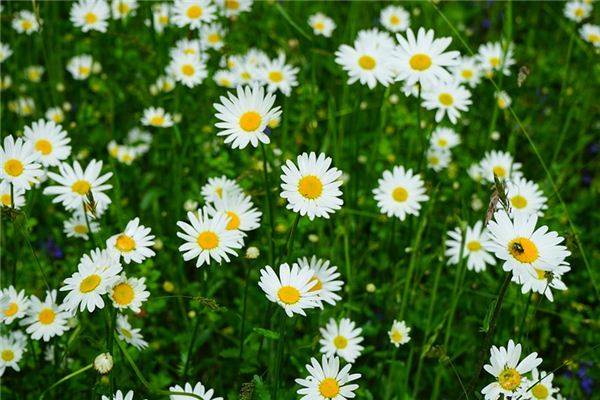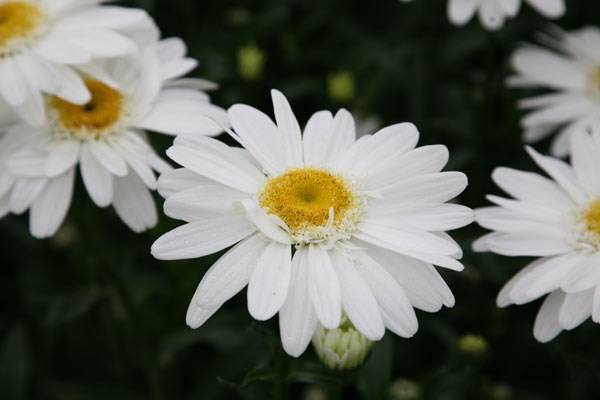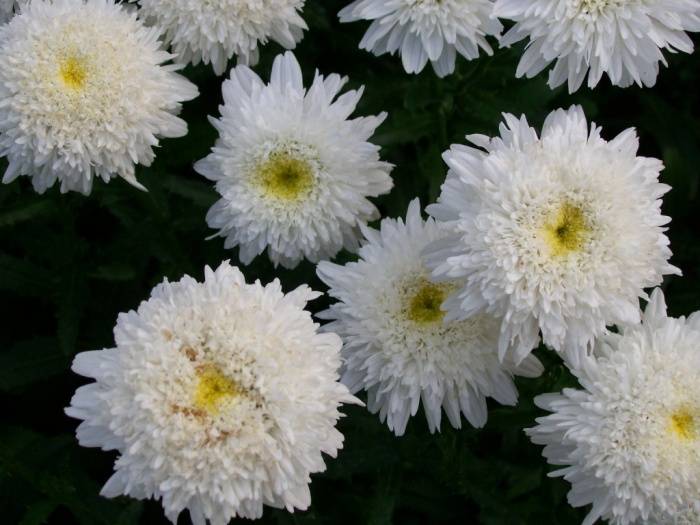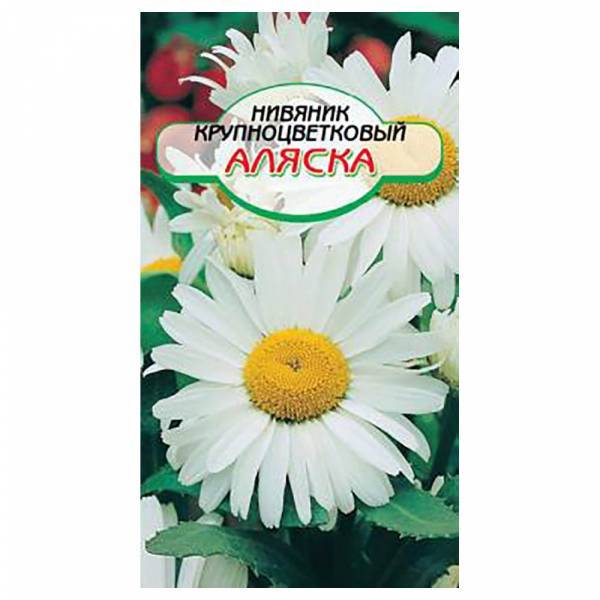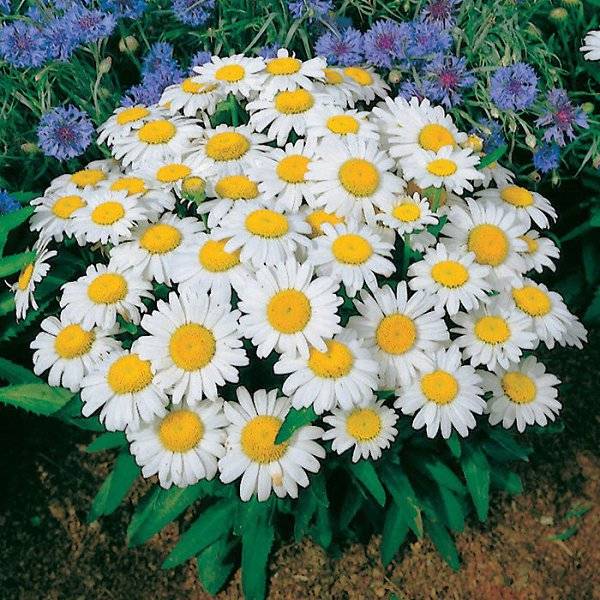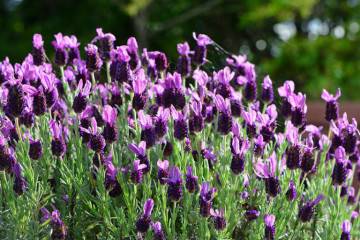Nivyanik ordinary - planting and care in the open field
Content:
Common daisy (Leucanthemum vulgare - in Latin) is often called popovka or meadow chamomile. The plant is found both in personal plots and in landscape design compositions. The absence of problems in cultivation allowed the culture to occupy a worthy niche among home flowers.
Common leucanthemum or leucanthemum (Leucanthemum Vulgare)
The plant is a representative of herbaceous perennials belonging to the Astrovye family. About 33 thousand species are registered in it, which are distributed throughout the planet. The culture prefers to grow in sunny meadows, forest glades, fields and gentle slopes. In places with constant shade, it does not take root.
The origin and appearance of the nivyanik plant
The culture grows up to 80 cm in height, the root system is represented by a rod with well-developed lateral processes. The stems are strong and straight, each has a flower basket, 7 to 10 cm across.
The appearance of the foliage depends on the variety and can be in the form of basal leaves with crenate edges or elongated stem leaves with a jagged border. The cylindrical achene (fruit) ripens by September or October, immediately after the end of the flowering season.
Description of the flower of the plant Nivyanik
Nivyanny flowers adorn household plots for two months. They are collected in a flower basket, with a diameter of up to 6 cm. In the middle are tubular, with a yellow color, along the edges - reed, with a white tint.
Other types of nivyanik
In addition to the ordinary species, there are several more varieties:
- The largest cornflower - with a large number of shoots of 50-100 cm, a shortened rhizome and large baskets up to 12 cm in diameter. Large-flowered inflorescences outwardly resemble chrysanthemum.
- Magnificent - the daisy refers to complex hybrids obtained by crossing different subspecies of the plant. The large and tall culture has large snow-white inflorescences with a golden central part. Its famous varieties include Victorian Secret with frost resistance up to -34 degrees, and Real Nit, up to 45 cm high.
Terry chamomile Crazy Daisy
The flowers of the voluminous plant resemble an aster. The dissected petals look disheveled, the combination of dark green leaves and snow-white inflorescences is quite impressive. Crazy Daisy chamomile is often used for bouquets or landscaping.
Common Nivyanik varieties
Hybrid varieties of perennial daisy have different sizes, volume and color of inflorescences.
May Queen
It is distinguished by its low growth, not exceeding 50 cm. Foliage of a decorative type, with a dark green tint, shiny leaf plates create dense rosettes. The flowers are snow-white.
Maxima kenig
Grows up to 1 m, large inflorescences, up to 12 cm in diameter. Reed flowers are arranged in two rows, in the center - tubular, dark yellow tone. Flowering is long and abundant, for a month and a half.
San-Souci
The bushes reach 1 m in height. Terry cornflower with snow-white baskets arranged in 6 rows. The buds form from mid-summer and last until the end of August.
Silver spoons
Tall bushes exceed 1.2 m. The peculiarities of the subspecies include the unusual shape of the petals: incomplete disclosure, resembling a spoon in appearance. The main flower is yellow, with light greenery around the edges.
New varieties of nivyanik (popovnik)
Certain subspecies of culture have unusual inflorescences that amaze with their beauty. The main difference from the classic look is the color of the petals and their number. Plants are included in the subgroup with double and semi-double inflorescences.
Nivyanik Goldfinch
Unusual and decorative subspecies. The goldfinch daisy has yellowish petals, which by the time of wilting change the main shade to cream. Compact bushes grow up to 70 cm, flowering continues from the first month of summer to the last.
Nivyanik Kings Crown
The flowers of this subspecies are not like chamomile: the petals are arranged in several rows, their size decreases gradually, from the outer edge to the core. In the Kings Crown daisy, the buds are colored unevenly - small petals are light yellow, along the edge - snow-white.
Nivyanik Aglaya
Double flowers with narrow petals are densely located near a small yellow center. In Aglaya cornflower, flowering lasts the entire summer period, and in warm areas - until early October.
Planting the daisy in open ground
Chamomile nivyanik is planted under the open sky in the last week of May. A month before planting, the seedlings are hardened - the plants are taken out into the air, gradually increasing the time spent in cool conditions.
For planting young animals, holes are prepared, the soil is abundantly moistened and one unit is placed in each. After the end of the procedure, water is re-watered.
Growing a lemongrass from seeds
Seed material is sown in the last week of February or the first of March. With the correct work, the first flowering can be observed in the same season. A step-by-step planting scheme involves the following actions:
- Drainage is laid out in a flat container - expanded clay or broken brick.
- The nutrient mixture is poured on top - a finger-thick distance should remain to the edge of the box.
- The earth is watered with warm water.
- The seeds are evenly distributed over the entire surface.
- From above they are covered with soil - the layer thickness should not exceed 10 mm.
- Planting does not need to create a greenhouse effect - young shoots will hatch on their own, subject to a temperature regime of 20-21 degrees.
- After the sprouts appear, the temperature is lowered by a couple of degrees.
When to plant seedlings
Nivyanik when grown from seeds, when should you plant for seedlings? The exact time depends on the climatic characteristics of the region. In cold areas, planting activities are carried out 2-3 weeks later than in warm ones.
Seeds for planting a cornflower
When choosing seed material, flower growers are advised to pay close attention to the marking and type of plants. Preference should be given to proven companies known in the market.
It will not be possible to grow varietal varieties of the daisy from independently collected seeds - the grown crops will lose most of their parental qualities or, instead of semi-double flowers, they will give ordinary ones.
Choosing the best place for the nivyan
If you want to grow a culture, you must adhere to the following rules:
- the plant prefers fertile soils with low acidity, sufficient moisture and excellent drainage;
- flowers react positively to organic fertilizers, which are applied before planting seedlings at the rate of 15 kg per 1 m2;
- during flowering, the plant is fed with compost or bone meal;
- it needs bright sunlight; it can die when landing in dark areas.
Nivyan care
It is not difficult to take care of the crop - the process does not require special knowledge or the use of rare fertilizers, compliance with the regimes. For a plant, the standard activities included in the formula for caring for flowers planted outside are enough.
The list includes:
- Watering - the priest will calmly survive a short drought. The soil is moistened as it dries up, 10 liters of liquid is required for each m2. Watering frequency should not exceed 2 times a month.
- Top dressing - if the soil was properly prepared during the planting of young stock, then the first fertilizer is applied after 3-4 years. Mineral or organic solutions are used, the plant is watered abundantly a day before their introduction.
- Weeding - done 24 hours after the soil is moistened. At the same time, all sprouted weeds are removed, the soil around the seedlings is mulched.
- The culture is rarely attacked by pests or diseases. With proper grooming, the problem occurs in exceptional cases.
Fulfillment of the main points of the recommendations will allow you to get an actively growing and lushly blooming garden. After the buds fall, the stems are shortened, the plant does not lose its decorative appearance until the end of the warm season.
Unpretentious specimens can be found on any personal plot. New varieties are more suitable for creating flower beds and landscaping due to the shape and color of the inflorescences, the size of the bushes and the length of the shoots. It is easy to grow a daisy - it is suitable even for beginners in floriculture.

